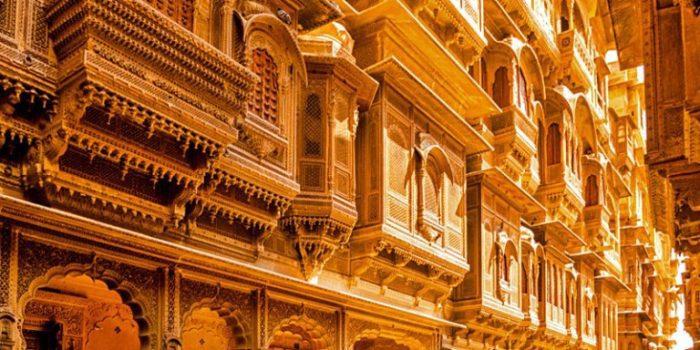Patwon ki Haveli – The Sustainable Architecture of Rajasthan in 19th Century
An architectural wonder of the bygone era, Patwon Ki Haveli is one of the main attractions that one can look for in the city of Jaisalmer. The Patwon Ki Haveli is a cluster of five small Havelis, the exteriors of which are dipped in an enchanting shade of gold.
History of this magnificent structure dates back to 18th century. Once the residence of rich traders of Jaisalmer Patwas, the Haveli was constructed in the span of fifty years by Guman Chand Patwa and his five sons. A true specimen of Rajputana sculpture, the Patwon Ki Haveli is famous for its exclusive mirror work and fine wall paintings.
Amongst the five Havelis which form the entire complex, one has been converted into a museum which displays a vast collection of antique furniture and decorative goods. Besides this, the third Haveli or mansion in the premises also houses rich items that include traditional art and craft work of the local craftsmen.

The Patwon Ji ki Haveli is an interesting piece of Architecture and is the most important among the havelis in Jaisalmer. This is precisely because of two things, first that it was the first haveli erected in Jaisalmer and second, that it is not a single haveli but a cluster of 5 small havelis. The first among these havelis was commissioned and constructed in the year 1805 by Guman Chand Patwa and is the biggest and the most ostentatious. It is believed that Patwa was a rich man and was a renowned trader of his time. He could afford and thus ordered the construction of separate stories for each of his 5 sons. These were completed in the span of 50 years. All five houses were constructed in the first 60 years of the 19th century.
The havelis are also known as the ‘mansion of brocade merchants’. This name has been given probably because the family dealt in threads of gold and silver used in embroidering dresses. However, there are theories, which claim that these traders made considerable amount of money in Opium smuggling and Money-lending. This is the largest Haveli in Jaisalmer and stands in a narrow lane. This haveli is presently occupied by the government, which uses it for various purposes. The office of the Archeological Survey of India and State art and craft department is situated in the haveli itself.
Nevertheless, even after these encroachments and abuse you can find a good amount of paintings and mirror-works on the wall. The other important aspects are its gateways and arches. You will notice individual depictions and theme on each and every arch. Although the whole building is made yellow sandstone, the main gateway of the Patwon Ji ki Haveli is in brown color.








